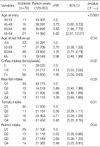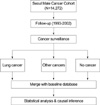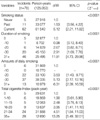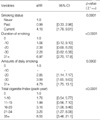Abstract
Lung cancer is the leading cause of cancer deaths in Korea. The aim of this study was to estimate lung cancer risk of cigarette smoking in Korean men by a 10-yr follow-up prospective cohort study using the primary databases. The number of subjects was 14,272 men, who had full information of smoking habits among participants in the Seoul Male Cancer Cohort Study (SMCC). Total 125,053 person-years were calculated by determining the number of days from the start of follow-up, January 1, 1993, until the date of lung cancer diagnosis, death from another cause, or the end of follow-up, December 31, 2002, followed by converting the number of days to years. The information of outcome was obtained by the database of Korea Central Cancer Registry, Seoul Regional Cancer Registry, and Korea Statistical Office. The relative risk (RR) and its 95% confidence interval (CI) values of smoking were calculated using Cox proportional hazards regression stratified on potential confounders. During the follow-up periods, 78 cases of lung cancer occurred. The cigarette smoking is the major risk factor and increases the 4.18-fold risk of lung cancer in Korean men. In order to control lung cancer, intervention of quitting smoking is needed.
Lung cancer is the most common cancer in the world (1) and is the leading cause of cancer deaths in Korea (2). It is estimated that lung cancer will continue to be the leading cause of cancer deaths among Korean people for the next 20 yr (3, 4).
While the epidemiological evidence linking smoking to risk of lung cancer is extensive (5), there are several reports that smoking is the important risk factor of lung cancer in Koreans (4, 6, 7). However, studies by Kim et al. (4) and Jee et al. (6) focused on mortality instead of the incidence of lung cancer. And the baseline information for the study by Yun et al. (7) as well as the previous two studies (4, 6) was obtained from a secondary source constructed by a business program of the National Health Insurance Corporation in spite of the outcome as the incidence of lung cancer. In order to estimate the magnitude of association between smoking and lung cancer in Koreans more exactly, a population-based prospective cohort study with a focus on the cancer incidence using a primary source was needed.
Thus, this study was designed to add to the body of knowledge regarding smoking habits and lung cancer risk in Korean men based on a population-based prospective cohort study.
The study cohort was constructed from the Seoul Male Cancer Cohort (SMCC), which has been partially reported elsewhere (8-11). The criteria of the eligible population were male beneficiaries of the Korea Medical Insurance Corporation (KMIC), confirmed to be healthy by the medical screening in 1990; aged between 40 and 59 yr in 1993; and living in Seoul, the largest city in Korea. The KMIC included government employees, school teachers, and pensioners living with their families since 1978. The nationwide total number of beneficiaries was around 4.7 million in 1992, which is about 11% of the total Korean population. To assemble a cohort size of at least 14,000 men, we mailed the self-administered questionnaire to 29,918 eligible papulation sampled at leact three times in 1992. Finally, we received completed, usable questionnaires having full information on smoking habits from 14,272 men, giving a response rate of 47.7%. The age distribution of this cohort was very similar to that of the Korean population.
Follow-up was done over 10 yr from January 1, 1993 to December 31, 2002 (Fig. 1). Incident cases of all cancers, including lung cancer, occurring during the 10-yr follow up period were identified through the database of Seoul Regional Cancer Registry as a population-based cancer registry (12, 13), the Korea Central Cancer Registry as a nationwide, hospital-based, cancer registry (14), and death certificates in the Korea Statistical Office (2).
While the never smoker was defined as a total consumption in the whole life of less than 20 cigarettes, we classified subjects by smoking status (never, past, or current), duration of smoking (0, 1-10, 11-20, 21-30, or 31+ yr), daily amounts of smoking (0, 1-10, 11-20, 21-30, or 31+ cigarettes/day), and total cigarette index (TCI) obtained by smoking duration times daily amounts of smoking (0, 1-10, 11-15, 16-20, 21-34, or 35+ pack-year).
A potential confounder among the variables of the baseline survey was defined as a variable showing a statistical significance based on the crude relative risk (cRR) of lung cancer. By this definition, the following five potential confounders were chosen: intake of coffee, raw fish, tomato, and retinol, as well as the age at entry (Table 1).
The age at entry was grouped into 5-yr groups of 40-44, 45-49, 50-54, and 55-59 yr old. The frequency of coffee intake was measured using three categories: 0, 1-6, or 7+ cups per week. Information on consumption of raw fish, tomato, and retinol was collected by semi-quantitative, food frequency methods. After converting to gram equivalents, the covariates with an unknown cut-off value were categorized according to quartile.
Total person-years were calculated by determining the number of days from the start of follow-up, January 1, 1993, until the date of all cancer diagnosis, death from another cause, or the end of follow-up, December 31, 2002, after which the number of days was converted to years.
The adjusted relative risks (aRR) of variables of smoking habits were calculated using the Cox proportional hazards regression adjusted for potential confounders. The proportional hazards assumption was examined by preparing log (-log) plots of the survival function. Confidence intervals were obtained by the Wald method and all reported p-values are two sided. The chi-square test for trend was used to evaluate linear trends. Analyses were conducted using STATA version 8 (15).
During the total 125,053 person-years of follow-up, 78 newly diagnosed cases of lung cancer were identified from the 14,272 study participants. Table 1 gives the results of univariate analysis for potential confounders including age at entry. While there was a statistical difference between groups by age at entry, intake of coffee showed a positive significant association and dose-response relationship. The cRR of intake of raw fish, tomato, and retinol indicated their protective value.
Table 2 shows the cRR of four variables related to smoking habits-smoking status, duration of smoking, amounts of daily smoking, and TCI. The cRR of current smokers, duration of smoking over 31 yr, amounts of daily smoking over 31 cigarettes, and the total cigarette index over 35 pack-year were 5.12, 16.05, 6.31, and 13.25, respectively. In other words, current smokers, a longer duration of smoking, larger amounts of daily smoking, or a higher total cigarette index exhibited higher risk of lung cancer.
When age at entry, intake of coffee, raw fish, tomato, and retinol were controlled as potential confounders based on the results of Table 1, the aRR in current smokers, duration of smoking over 31 yr, amounts of daily smoking over 31 cigarettes, and total cigarette index over 35 pack-year were 4.18, 6.97, 4.79, and 8.55, respectively (Table 3). These observations were interpreted that four variables of smoking habits showed the statistical significance and dose-response relationship even after adjusted for confounders.
It is important to identify factors that influence a smoker's risk of developing lung cancer in order to better understand the etiology of the disease, and to more effectively target high-risk individuals for prevention and screening interventions.
The etiological role of cigarette smoking in inducing lung cancer has been well known since the early 1950s and constitutes the largest body of scientific evidence on the carcinogenic effects in humans from exposure to chemicals (5). In addition to the fact that about 90% of cases are thought to be tobacco-related (16), there is a clear dose-response relationship between lung-cancer risk and the number of cigarettes smoked per day, degree of inhalation, and age at initiation of smoking (17, 18). While the risk estimates for lung cancer reported by the large cohort studies range approximately between 7 and 15 (19, 20), the relative risk from this study was 4.18.
Such a large heterogeneity of results was considered to be associated with three major sources of variation: factors inherent to the studies such as study design, response rates, and statistical power; characteristics of smoking habits in the different population studies; and differential distribution of confounders and effect modifiers (21). First of all, the interpretation of results should involve the study design because the apparent decrease of the ORs is related to the artefact of the relative risk comparison, which tends to mask the freezing of the absolute risk at the time of quitting smoking. Second issue as various smoking habits in the different population would be related with the fact that Asian men has a lower number of cigarette smoked per day rather than Western men and the prevalence of smoking began to rise in the 1960s and 1970s (6). Based on these backgrounds, the effect of smoking is consistently lower in Asian countries than in studies of smokers in several western countries (16, 19). The final issue about differential distribution of confounders and effect modifiers could be considered by various risk estimates of previous studies in Korean men. While the RR of Jee et al. (6) and Yun et al. (7) were 4.0 (95% CI: 3.5-4.4) and 3.83 (95% CI: 2.97-4.94), respectively, these studies were conducted using secondary databases. In other words, the two studies used the data collected as part of an insurance plan so that the validity of self-reported smoking information was suspected of doubt and the adjustment for confounders or effect modifiers should be limited (6). On the other hand, this study used the primary database constructed to investigate risk factors of major cancers in Korean men. In addition to the merit above, this study assessed the incidence of lung cancer. If a study was based on cancer mortality data, the effect of smoking on the cancer incidence might have been confounded by its effect on other fatal diseases, such as cardiovascular disease (22).
In spite of these strengths, this study had some limitations. Firstly, the cohort participants were restricted as men aged between 40 and 59 yr-old at entry. Because of this reason, age at the latest follow-up was not different according to occurring lung cancer. The inference of results should be restricted for middle-aged men. Secondly, a chance of misclassification of grouping in self-reported smoking habits could not be excluded even if the validity studies were done at cohort constructed. Especially, we disclosed a never smoker in the questionnaire as a total consumption in the whole life of less than 20 cigarettes, but misclassification of current smokers as never smokers in this study could result in an underestimated cancer risk.
In conclusion, this study reconfirmed that smoking increases the risk of lung cancer in middle aged Korean men by 4.18-fold. Because the health burden from smoking-related lung cancer among Korean men will increase in the near future, anti-smoking program should be done strongly.
Figures and Tables
Table 1
Crude relative risks (cRR) and their 95% confidence intervals (CI) of lung cancer by potential confounders*

References
1. Greenlee RT, Hill-Harmon MB, Murray T, Thun M. Cancer statistics, 2001. CA Cancer J Clin. 2001. 51:15–36.

2. Korea National Statistic Office. 18 September 2006. http://www.nso.go.kr/board_notice/BoardAction.do?method=view&board_id=78&seq=388&num=388&parent_num=0&page=1&sdate=&edate=&search_mode=&keyword=&position=.
3. Bae JM, Jung KW, Won YJ. Estimation of cancer deaths in Korea for the upcoming years. J Korean Med Sci. 2002. 17:611–615.

4. Kim IS, Jee SH, Ohrr H, Yi SW. Effects of smoking on the mortality of lung cancer in Korean men. Yonsei Med J. 2001. 42:155–160.

5. IARC. Tobacco. A major international health hazard. 1986. Lyon: IARC;IARC Sci Publ 74.
6. Jee SH, Samet JM, Oh H, Kin JH, Kim IS. Smoking and cancer risk in Korean men and women. Cancer Causes Control. 2004. 15:341–348.

7. Yun YH, Jung KW, Bae JM, Lee JS, Shin SA, Park SM, Yoo T, Huh BY. Cigarette smoking and cancer incidence risk in adult men: National Health Insurance Corporation Study. Cancer Detect Prev. 2005. 29:15–24.

8. Bae JM, Ahn YO. A nested case-control study on the high-normal blood pressure as a risk factor of hypertension in Korean middle-aged men. J Korea Med Sci. 2002. 17:328–336.

9. Shin MH, Kim DH, Bae JM, Lee HK, Lee MS, Noh JY, Ahn YO. The effect of coffee consumption on serum total cholesterol level in healthy middle-aged men. Korean J Prev Med. 1994. 27:200–216.
10. Kim DS, Koo HY, Kim DH, Bae JM, Shin MH, Lee MS, Lee CM, Ahn YO. A cohort study of physical activity and all cause mortality in middle-aged men in Seoul. Korean J Prev Med. 1998. 31:604–615.
11. Lee MS, Kang WC, Kim DH, Bae JM, Shin MH, Lee YJ, Ahn YO. Methodologic considerations on the cohort study of risk factors of stomach cancer: on the incompleteness of case ascertainment. Korean J Epidemiol. 1997. 19:152–160.
12. Kim JP, Park IS, Ahn YO, Shin MH, Ahn DH, Kang TW, Ko UR, Ku PS, Kim KY, Kim KH, Kim NK, Kim DJ, Kim DH, Kim BS, Kim SH, Park CT, Min JS, Park TK, Woo BH, Yoo H, Lee SW, Lee SJ, Cho KS, Joo HZ, Ham EK. 1991 cancer incidence in Seoul, Korea: results of the implementation study of the Seoul Cancer Registry. J Korean Med Sci. 1995. 10:74–84.

13. Parkin DM, Whelan SL, Ferlay J, Teppo L, Thomas DB. Cancer incidence in five continents. 2002. VIII. Lyon: IARC;276–277. IARC Sci Publ 155.
14. The Korea Central Cancer Registry in National Cancer Center.
http://www.ncc.re.kr.
15. StataCorp. 1 November 2006.
http://www.stata.com.
16. U.S. Department of Health and Human Services. DHHS Publ No. (CDC)89-8411. Reducing the health consequences of smoking: 25 years of progress. A report of the Surgeon General. Rockville (MD): U.S. Department of Health and Human Services, Public Health Service, Centers for Disease Control, Center for Chronic Disease Prevention and Health Promotion, Office on Smoking and Health. 1989.
17. Agudo A, Ahrens W, Benhamou E, Benhamou S, Boffetta P, Darby SC, Forastiere F, Fortes C, Gaborieau V, Gonzalez CA, Jockel KH, Kreuzer M, Merletti F, Pohlabeln H, Richiardi L, Whitley E, Wichmann HE, Zambon P, Simonato L. Lung cancer and cigarette smoking in women: a multicenter case-control study in Europe. Int J Cancer. 2000. 88:820–827.

18. Yamaguchi N, Mochizuki-Kobayashi Y, Utsunomiya O. Quantitative relationship between cumulative cigarette consumption and lung cancer mortality in Japan. Int J Epidemiol. 2000. 29:963–968.

19. Doll R, Peto R. Mortality in relation to smoking: 20 years' observations on male British doctors. Brit Med J. 1976. 2:1525–1536.

20. Vineis P, Alavanja M, Garte S. Dose-response relationship in tobacco-related cancers of bladder and lung: a biochemical interpretation. Int J Cancer. 2004. 108:2–7.

21. Simonato L, Agudo A, Ahrens W, Benhamou E, Benhamou S, Boffetta P, Brennan P, Darby SC, Forastiere F, Fortes C, Gaborieau V, Gerken M, Gonzales CA, Jockel KH, Kreuzer M, Merletti F, Nyberg F, Pershagen G, Pohlabeln H, Rosch F, Whitley E, Wichmann HE, Zambon P. Lung cancer and cigarette smoking in Europe: an update of risk estimates and an assessment of inter-country heterogeneity. Int J Cancer. 2001. 91:876–887.

22. Baron JA, Rohan TE. Schottenfeld D, Fraumeni JF, editors. Tobacco. Cancer epidemiology and prevention. 1996. 2nd ed. New York: Oxford University Press;269–289.




 PDF
PDF ePub
ePub Citation
Citation Print
Print





 XML Download
XML Download